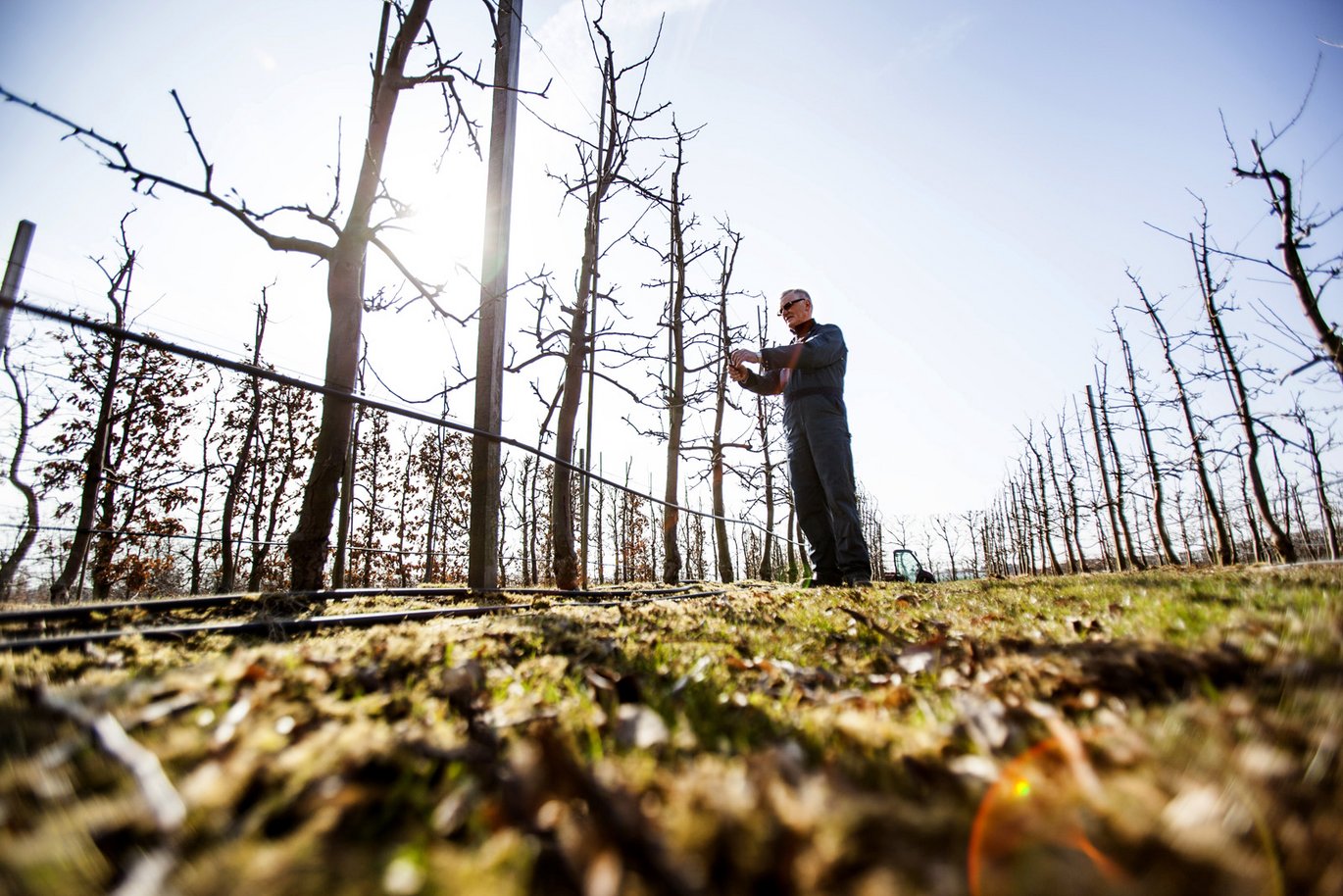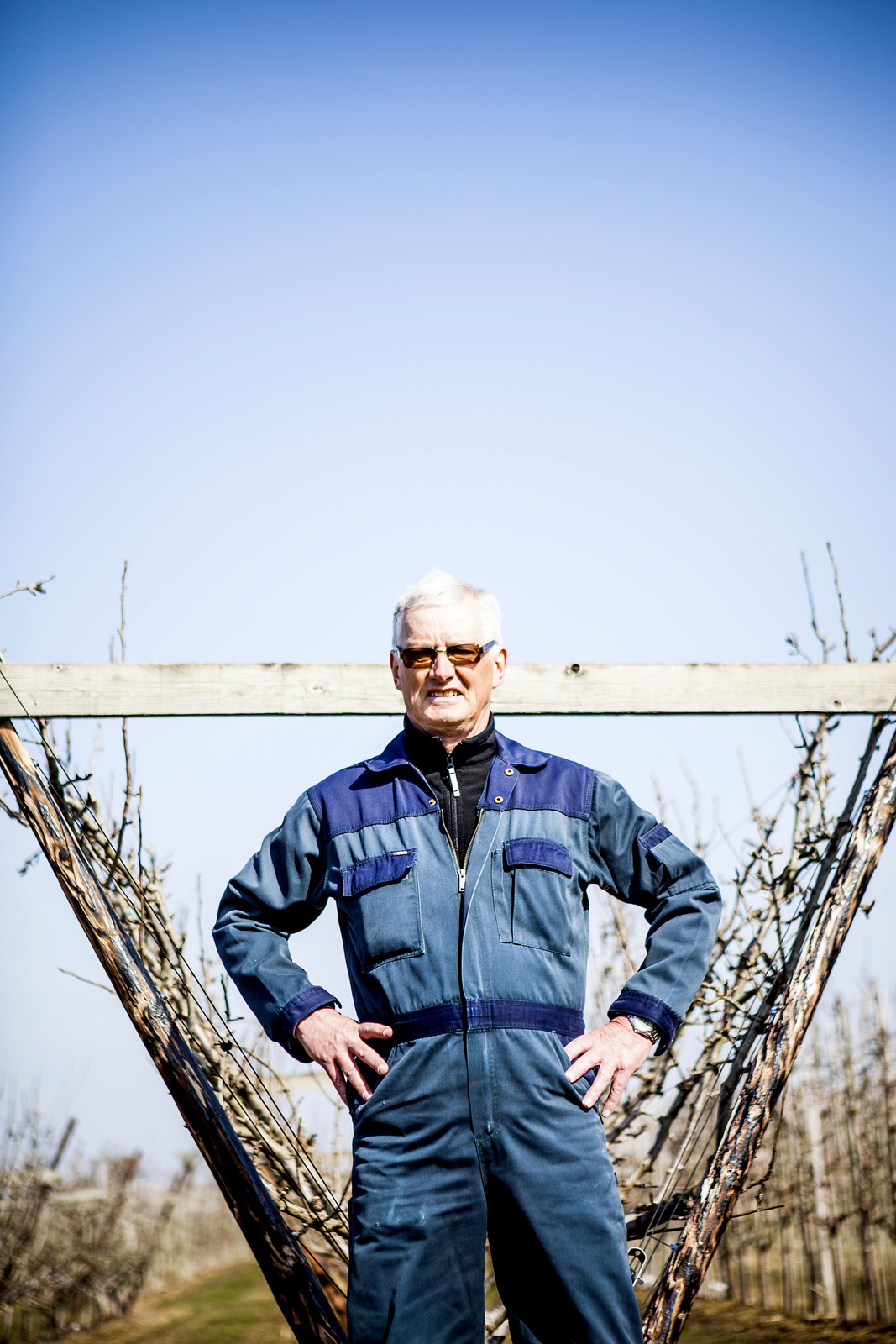An apple farmer in frosty weather
Fruit farmer Stig Bjarne Sørensen takes daily pleasure in the freedom he enjoys when working under an open sky in the Årslev experimental fruit farm on the island of Funen. But it’s not all mirth and jollity, because the demands involved in financing research projects don’t always match the time frames within which fruit farmers are forced to operate.


Just like any other day, Stig Bjarne Sørensen turns on his computer to check the weather forecast. Will he be doing some weeding or pruning today? Or will he have to spray the fruit trees to prevent blight? The weather gods always decide. Stig works on a 25-hectare fruit plantation used by scientists from the Department of Food Science for their research projects. He looks after the apple, cherry and pear trees. And he loves his job – even on an early spring day like today, when the weather is raw and cold.
V-shaped pear trees
“I love it here. The trees are my friends! I saw an osprey the other day – what a sight! The air was a bit milder a couple of days ago, and the bees started buzzing straightaway. And soon there’ll be larks, swallows and swifts on the wing,” says Stig, with a delight in his voice which reveals why he never feels lonely in his work on the plantation.
We pass a row of pear trees which have all been pruned in a big V shape to make sure the fruit gets as much light as possible while it grows.
“Professional fruit farmers are generally keen to try out new cultivation techniques – like this way of pruning pear trees, for instance. They’re always very critical, which is what I like about them. But they have to be critical because they need to plant 3,000-4,000 trees per hectare, which costs about DKK 200,000. And when they want to try something new, they normally have to plant a couple of hectares,” he explains.
The next thing he shows me is a group of spindle-shaped apple trees, pruned in a way that makes it seem like their branches are reaching out towards each other in long, straight rows.
“Here’s a perfect tree,” says Stig, stopping in front of an apple tree that (to my untrained eye) looks exactly like all the other professionally pruned trees.
“But no – look at this,” he says, grabbing a thin, 15-20 centimetre branch that bends gently away from the main trunk. It’s covered in small buds.
“There’ll be plenty of apples on this tree before too long”.
The trainee gardeners who Stig takes under his wing during their horticultural training benefit hugely from the knowledge he has acquired after many years of working on the plantation. Stig also keeps up with international developments in his field.
Interesting mistake
When we get to the organic section of the plantation, Stig points out one particular row of apple trees.
“These trees were planted by mistake. We were simply sent the wrong variety, so the research manager wanted the whole row cleared. I suggested leaving them alone, and last summer we got some interesting results that will be useful when counteracting blight in a variety which is often attacked by this disease. She thanked me for suggesting that we should leave the trees alone,” says Stig. He is clearly still delighted with that particular pat on the back.
Sprayed everything that moved
Stig has been working as a fruit farmer on experimental fruit plantations for more than 40 years now, so he remembers when pesticide spraying was a natural part of the job. It also used to be common practice for professional fruit farmers.
“We used to spray everything that moved,” he says.
But these days he adopts an entirely different approach, preventing the attacks of pests and diseases by applying insight and experience – thereby keeping the use of sprays to an absolute minimum in the conventional section of the experimental plantation.
“We now have very accurate early-warning systems to predict attacks of blight, and it’s also a question of using your knowledge of your plantation to make the right decisions. I decide whether it’s time to spray against blight when I see the level of moisture on the leaves. And based on the number of greenfly compared with the number of ladybirds (and not least the number of ladybird larvae, which eat ten times as many greenfly), I decide whether I need to take any action or whether the ladybirds can do the job without any help from me.
Cherry trees
But no matter how many little helpers Stig manages to attract, they’ll never be able to help him with what he sometimes perceives as short-termism when it comes to financing the experimental fruit farm.
One good example of this problem is the cherry trees that Stig had to look after in connection with one particular research project. When the project ended after five years, the department manager told him to clear all 500 cherry trees because the project financing had come to an end. Stig suggested that he should harvest the cherries instead of cutting down the trees – the harvest would have financed the trees until they could be used in a new research project.
“We could have harvested about 10 tonnes at a time when the fruit wholesaler GASA was paying DKK 5,000 per tonne for cherries.”
But Stig’s proposal fell on deaf ears, so he had to clear the area.
“The next year we were given new funding for a new project involving experiments with leaf spot on cherry trees, so I had to plant a load of new trees which couldn’t be used for research purposes for the first 2-3 years. We depend on our trees, and growing trees takes time. It’s not like growing cucumbers and tomatoes. So it is a bit hard when nobody listens to my suggestions for alternative financing options. The cherry trees were just one example – there are other areas which could provide a pretty good source of income to finance our fruit and berry experiments.”
The days are growing longer
Stig is clearly disheartened, and we stamp our feet in silence while a bitter wind blows around us. But when we walked along the row of spindle-shaped apple trees earlier, Stig saw the first ladybird of the year. And the thought cheers him up.
“I’ll carry on even though I’m 65 now, because the pleasure I get from the job outweighs the disappointments. Like discovering a courageous ladybird on a bitterly cold day in March. That’s the kind of thing that makes it a privilege to work so close to the natural environment.”
As far as Stig is concerned, the love of life depends on daylight more than anything else.
“The days are growing longer, and that’s great for us because as the days grow longer our optimism grows too. I can feel it when I’m out here helping the trees start a new growing season.”
Facts
Fruit farmer Stig Bjarne Sørensen
1967: Graduated as a fruit farmer from Gartnerhøjskolen Søhus
1972: Started working at the Danish Institute of Plant and Soil Science at Blangstedgård
1975: Passed his A-level exams after studying at evening school
1983: Transferred to Årslev
2012: 40th anniversary. Awarded the silver service medal
2013: Won the Fruit Farmer of the Year award, presented by the Committee for Fruit and Vegetables – the first public-sector employee to have achieved this distinction

